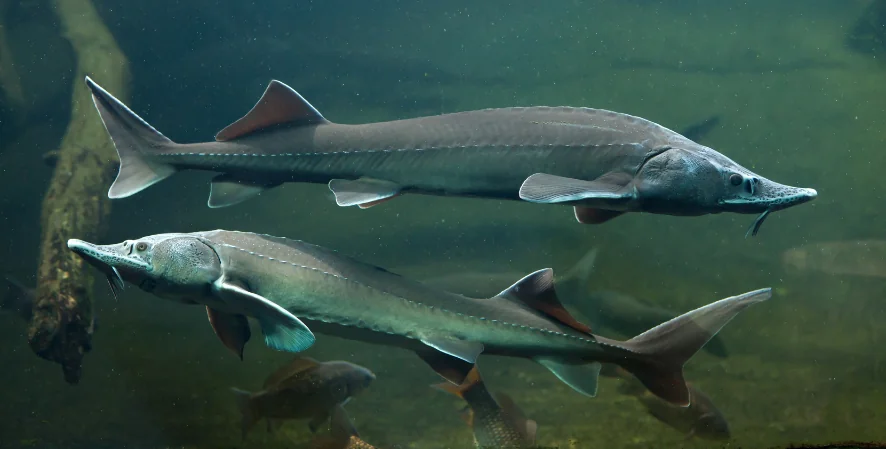
STURGEONS ON THE BRINK
It’s a scene that captures the imagination – and captivates the internet: a ten-foot sturgeon is tagged and released by a fishing guide in British Columbia. This ancient-looking, 500-pound creature is awe-inspiring, a gentle giant – but globally, seeing such a spectacle in the wild has become a very rare occurrence. Last week’s release of the IUCN Red List of Threatened Species chronicles the global demise of these ancient and majestic fish.
Of the 27 described species of sturgeon, 26 are now at risk of extinction (this means they are classed as Vulnerable, Endangered, Critically Endangered or Extinct in the Wild). The 27th, the Chinese Paddlefish (Phesurus gladius), is classified as Extinct. The Yangtze sturgeon (Acipenser dabryanus) was reclassified from Critically Endangered to Extinct in the Wild. All the A. dabryanus currently inhabiting the Yangtze River were artificially propagated and released; no wild-born Yangtze sturgeons exist anymore. There has been no evidence of natural reproduction for this species since 2000. Given the perilous situation of the Yangtze sturgeon, the species was recently included in a joint publication by the IUCN SSC Freshwater Conservation Committee, Shoal, and the Indianapolis Zoo on “Fantastic Freshwater” which highlights the diversity and beauty of 50 freshwater or wetland-dependent species and the threats they and their habitats face.
Sturgeons are an ancient lineage of fish. Having originated in the late Triassic period at a time when dinosaurs still roamed the Earth, they have changed very little in appearance over the course of their evolutionary history, and they are among the oldest and largest fishes in existence. Some sturgeons have reached up to 8 meters in length – compare that to the 10-foot (3-meter) sturgeon that went viral online earlier this year. Some individuals of the Critically Endangered Beluga (Huso huso) can reach 1,700 kg in weight!
Sturgeons have been overfished for their meat and caviar for centuries. With sturgeon fishing now prohibited practically everywhere, the approximately 500 tons of caviar produced annually stem from farmed animals – yet poaching still impacts more than half of these species. Given that they are long-lived species and don’t reach maturity until 10-20 years of age, these magnificent fish have long “generation lengths” – this means that the average age of individuals producing new offspring is relatively high and it takes a longer time for the population to replace itself. In short, it takes a long time for sturgeons to reproduce themselves out of trouble when threats such as overfishing hit! It is therefore not surprising that all of the remaining 26 species have been assessed as threatened based on dramatic declines witnessed over the past three generations (Red List insiders call this “Red List criterion A”, which looks at population declines over a time frame that is relevant to the species life history – other criteria based on other symptoms of extinction risk are of course available, and some of these have also been met by some sturgeon species!).
At least some of the species are ‘anadromous’, which means they spawn in freshwaters, but return to brackish or coastal waters to feed. This means that these sturgeons are highly dependent on accessible migration routes up and down rivers. Dams affect these migration routes and have also played a major part in the declines in sturgeon populations. Climate change is likely to exacerbate other threats as river warming may further disrupt sturgeon reproduction.
The outlook for sturgeons seems gloomy and the obstacles to achieving positive outcomes for these magnificent creatures are huge – sturgeon-sized in themselves! The ship sturgeon (Acipenser nudiventris) is one of the eight species found in Europe, but has been declared extinct in the Danube River, despite the protection granted to all sturgeon species under the 1992 Habitat Directive. Stronger enforcement of regulations on the illegal sale of sturgeon meat and caviar is critical to stop further declines.
However, freshwater ecosystem restoration, implementing effective fish passages to aid migration, and restocking of populations are tactics we can use to help sturgeons. These have already proven effective for species such as the Critically Endangered Adriatic sturgeon (Acipenser naccarii) which again has reproduced in the wild after three decades of silence. The rediscovery of ship sturgeon (Acipenser nudiventris) in the Rioni River, Georgia, is also a positive sign. The populations doing best are generally found in North America. Here, conservation programs and management interventions were put in place before populations reached a critical level; however, declines are still evident in many populations in North America. The shortnose sturgeon (Acipenser brevirostrum), distributed in many of the large coastal rivers of eastern North America, is listed as Vulnerable, with several stocks appearing stable, even increasing in a few large rivers – although southern populations remain low. There is much work to be done – and thankfully, several organizations are active in policy, fisheries and aquaculture spheres, and provide the necessary data to bring about positive outcomes for sturgeons. Check out the WWF, the World Sturgeon Conservation Society, and the IUCN SSC Sturgeon Specialist Group for more information on these ancient, magnificent creatures.
This blog was a collaboration between experts with the IUCN SSC Sturgeon Specialist Group and the Global Center for Species Survival, including Freshwater Conservation Coordinator Dr. Monni Böhm.
Published July 27, 2022

